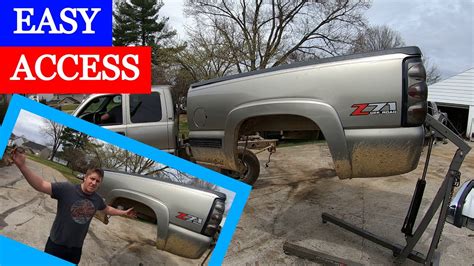The Easiest Way to Remove a Truck Bed: Revealed!
Removing a truck bed might seem like a daunting task, conjuring images of heavy machinery and Herculean effort. However, with the right approach and tools, it's a surprisingly manageable project for even moderately handy individuals. This guide will break down the process into easy-to-follow steps, revealing the easiest way to remove a truck bed and get you back on the road (or off-road!) in no time.
Understanding Your Truck's Specifics
Before diving in, it's crucial to understand your truck's make, model, and year. Different trucks have variations in their bed attachment systems, affecting the complexity of removal. Consult your owner's manual; it’s your best friend for this process! This manual will detail the specific bolts, clamps, and electrical connections unique to your vehicle. Ignoring this step could lead to unnecessary complications and potential damage.
Tools You'll Need
Gathering the necessary tools beforehand is key to a smooth and efficient removal. You'll likely need:
- Sockets and Wrenches: A variety of sizes, including metric and standard, to handle all the bolts securing the bed.
- Ratchet: A good quality ratchet will significantly speed up the process.
- Extension Bars: These will be invaluable for reaching hard-to-access bolts.
- Jack Stands: Absolutely essential for safety. Never work under a vehicle supported only by a jack.
- Jack: A floor jack is ideal for lifting the truck bed.
- Wheel Chocks: To ensure the truck remains stationary.
- Gloves: To protect your hands.
- Safety Glasses: To protect your eyes from flying debris.
- Penetrating Oil (PB Blaster or similar): Applying this to bolts before loosening them will prevent stripping.
- Wires/connectors (if applicable): To disconnect the lights/wiring to the bed.
Step-by-Step Guide to Truck Bed Removal
This guide provides a general overview. Always refer to your owner's manual for precise instructions tailored to your specific truck.
1. Disconnect the Tailgate
Start by disconnecting the tailgate. This typically involves removing a few bolts or pins.
2. Disconnect Electrical Connections
Locate and carefully disconnect any electrical connectors running to the bed lights, and the truck bed's sensors (if applicable). Take photos or make notes to help you reconnect everything later.
3. Remove the Bed Bolts
Most truck beds are secured by bolts located along the sides and rear of the bed. Use penetrating oil on these bolts to ease removal. Work methodically, removing one bolt at a time.
4. Safely Lift the Bed
Once all the bolts are removed, carefully use the floor jack to lift the truck bed slightly. Position the jack stands for stability before completely lifting the bed.
5. Carefully Lower the Bed
Slowly and carefully lower the truck bed using the jack. Have an assistant help guide the bed to prevent damage.
6. Clear the Area
Once completely removed, carefully set aside the truck bed.
Troubleshooting Common Issues
Stuck Bolts: If you encounter stubborn bolts, apply more penetrating oil and let it sit for a while. Consider using a breaker bar for extra leverage.
Damaged Bolts: If a bolt breaks, you may need to use bolt extractors or drill it out.
Wiring Issues: If you're unsure about disconnecting the wiring, consult a professional.
What to Do After Removal
After successfully removing the truck bed, thoroughly inspect the frame rails for any damage or rust. This is a good opportunity to clean and maintain this area. Once you’ve completed the repairs or modifications you’re undertaking, reinstalling the truck bed follows the steps above in reverse order. Remember to secure everything tightly!
By following these steps and taking the necessary precautions, removing your truck bed will be a smoother, easier, and safer experience than you might initially expect. Remember, safety should always be your top priority. If you are unsure about any step, seek the advice of a qualified mechanic.

